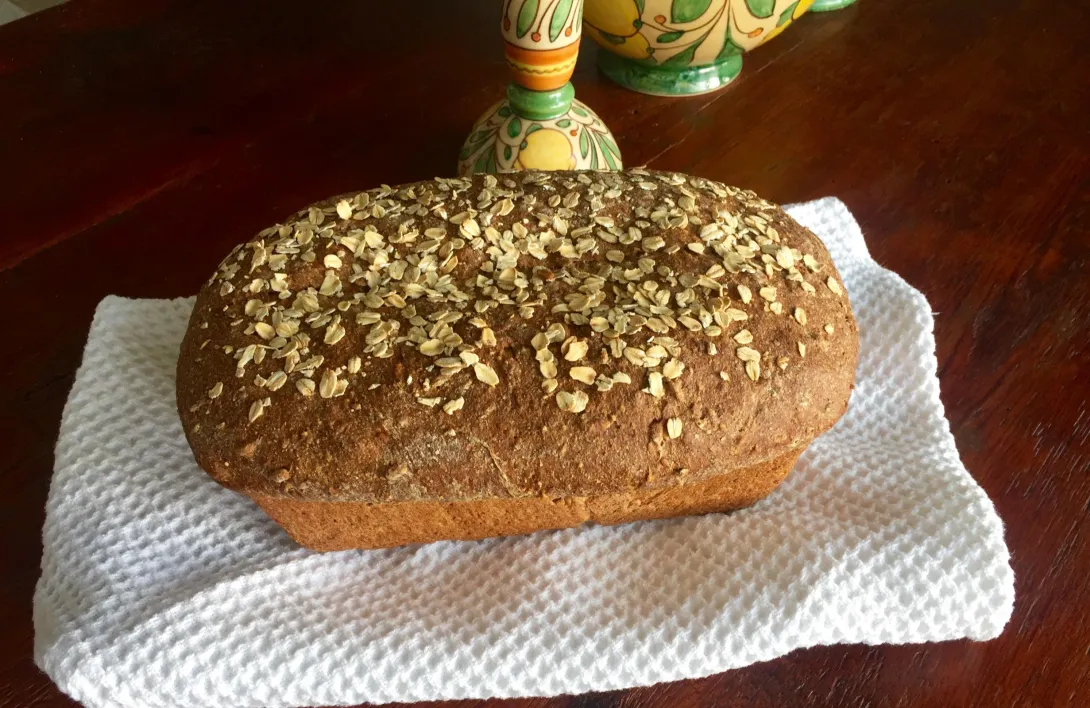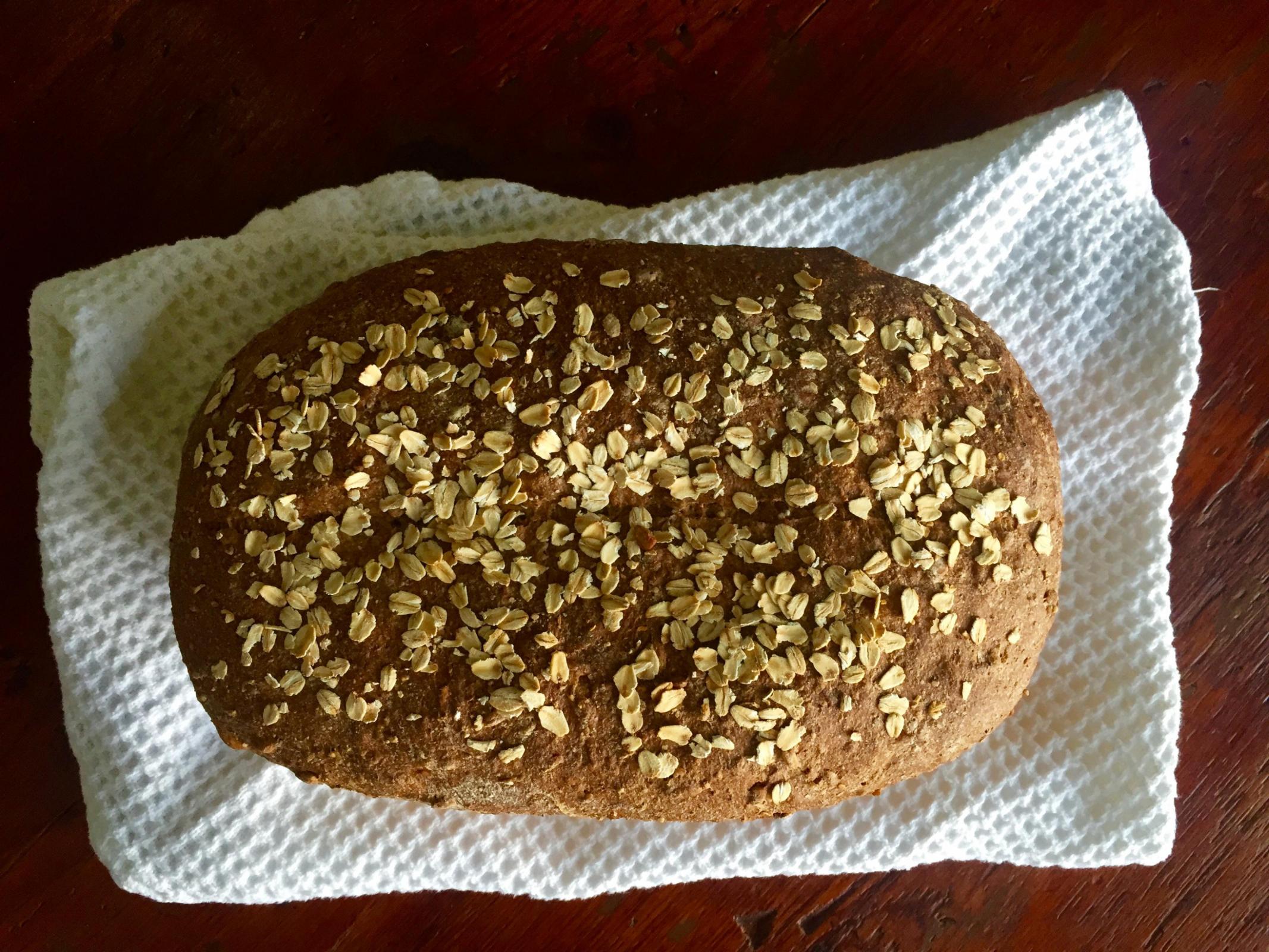
I was shopping this morning at my local natural food store and lingered too long in the grain aisle. And this happened. I bought some hard red wheat berries thinking I'd throw them in the Vitamix and see what happens. And this happened. About 500g fresh milled whole wheat (my first time - no, not a proper mill, but whatev) and about 200g organic sprouted spelt flour (both on eyeball), about 600g warm water, about 3/4c Bob's Red Mill 10 Grain Cereal (dry, not cooked), 2 handfuls (about 1/2c??) KAF Harvest Grains Blend (dry, not soaked), 2 TBL VWG, 2 TSP diastatic malt powder, 1 decent pour (about 2 TBL??) of wildflower honey, what looked like 18-20g fine sea salt, about 1/3c toasted chopped pecans, 1 TBL instant yeast. Autolyse with everything (except yeast & salt) for 10-12 minutes - then throw in the yeast and salt. squeeze it all together and then knead for a few minutes until it comes together. (I used a bit of KAF Artisan Bread Flour as needed while kneading.) Raise in covered oiled bowl for 75 minutes; de-gas a bit; shape, transfer to lightly oiled loaf pan, cover, let rise for about an hour; bake at 350 for about 70 minutes until reached 195-200 degrees. Tented last ten minutes. YUM. (I knew it was rather oversized for the loaf pan, but didn't care. It's what I had on hand.)

- Runnerfemme's Blog
- Log in or register to post comments
You know you are talented in bread making when you can make a loaf like that without measuring! I am totally impressed!!!
I had zero plans to bake again this weekend but there they were - these adorable little bags of wheat berries. I had to take them home. I remembered when I was searching the internet for reviews on home mills that there was a video on milling using the Vitamix wet blade (not the proper dry blade which is intended for grinding grain). So I figured, why not? I now have more bread than I know what to do with! :) It was fun.
I have made my best loaves like this. Hands were the first measuring cups and when you get your hands into the dough, you really learn what the ingredients actually DO
If the Vitamix flour was a little coarser than usual, just find a way to soak the dough a bit longer. Add a bit more liquid and do an overnight cold retard. I have made my absolute best multigrain, wholegrain bread that way. It is always soft and sliceable when I do that. Use only 1 tsp of instant dry yeast rather than a packet (2 1/4 tsp) if you do this. Mix/knead it well and put it in a greased, covered container overnight.
Isn't bread delicious fun?
Yes, yes, yes. I've been baking bread only since May and have been spending a lot of time on it every weekend, which means I have been cooking (ordinary cooking, not bread baking) less than I usually do. I LOVE cooking - I do a lot of reading and then just sort of do my thing. As much as I love bread baking, I do miss the more free-wheeling nature of cooking at my stove top by following my nose and not a scale. Baking this way (as described in this blog) was really rather liberating (it doesn't take much, apparently...) and reminiscent of instinctive cooking. Even though it wasn't SD, it was delicious. It was toothsome and not bitter and wonderfully tasty. You're right that the flour was a bit gritty, but I sort of liked it - but I bet an overnight in the cold would be a wonderful conditioner. I didn't add any fats, so maybe a nob or two of butter would be a good idea too. In re-reading this blog tonight, I somewhat regret the tone - I was so enthralled that I fear it came off as cocky when really I was just excited! :)
and it worked great till I burned it up. Your method should last a whole lot longer.
The thing about whole grains is that the enzymes haven't been removed by sifting out the hard bits like a white flour where they are added back in using diastatic malt. Plus, sprouting grain is the first step in making diastatic malt so your sprouted flour in the mix has extra diastatic power in it too in it too. Plus the short autolyse also lets the enzymes have a bit of a head start and then there is the honey - plenty of food for the yeast to munch on.
Like C123 says, If you autolyse longer in the future to improve the crumb and you use much less yeast to slow things down to really bring out the flavor of the grains, you are going to want to drop the malt from this mix to get the best results
I'm pretty sure the diastatic malt you added to the mix is not needed at all as it is. Other than a bit of over proofing, this one really had to be moving along very, very fast, the recipe and the outcome were spot on. It is fun to make a tasty, hearty, healthy bread without measuring and this one was all of those things.
Well done and happy baking
This is just the sort of advice and know-how I needed! Thank you!